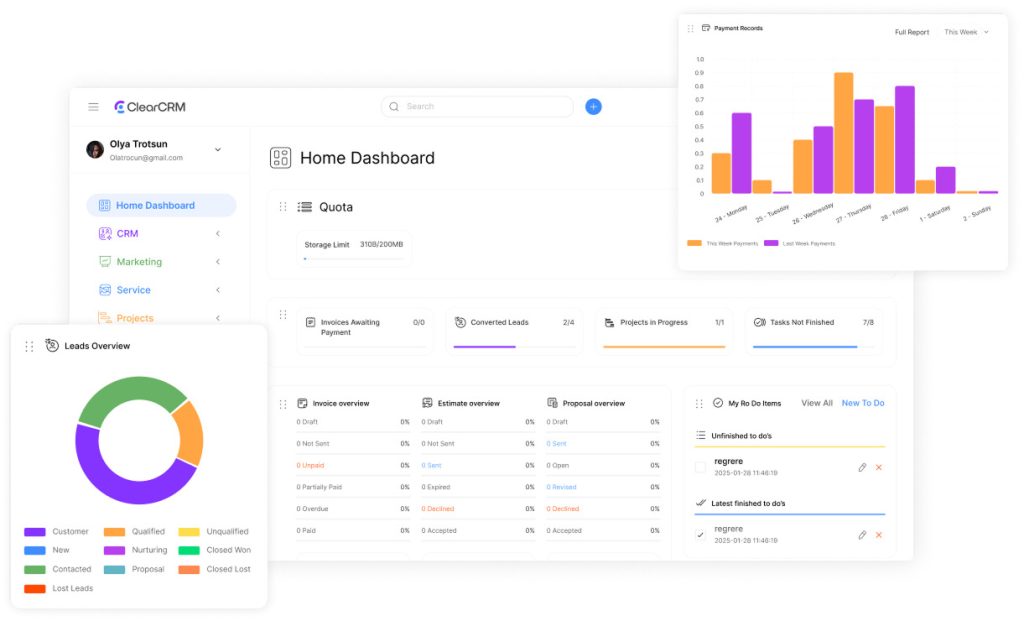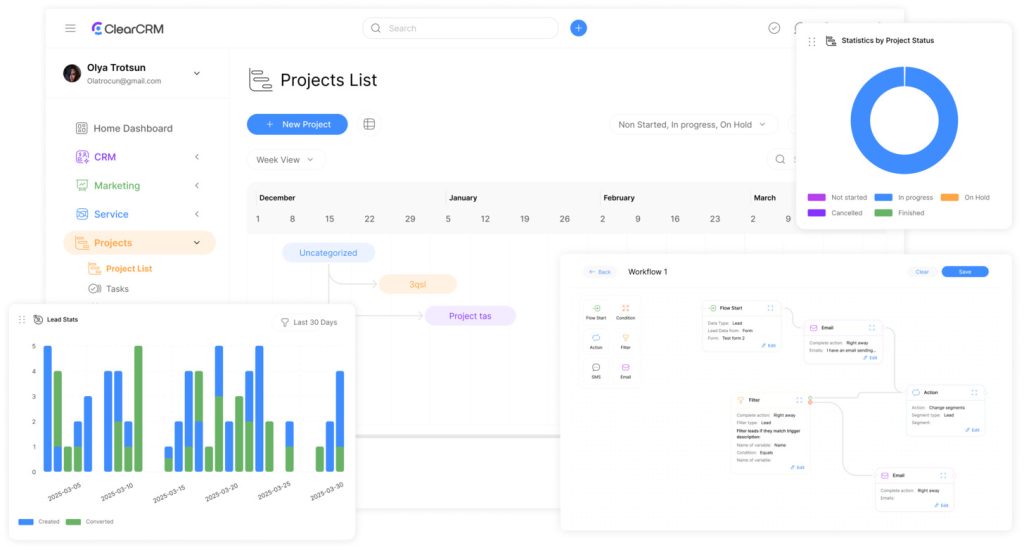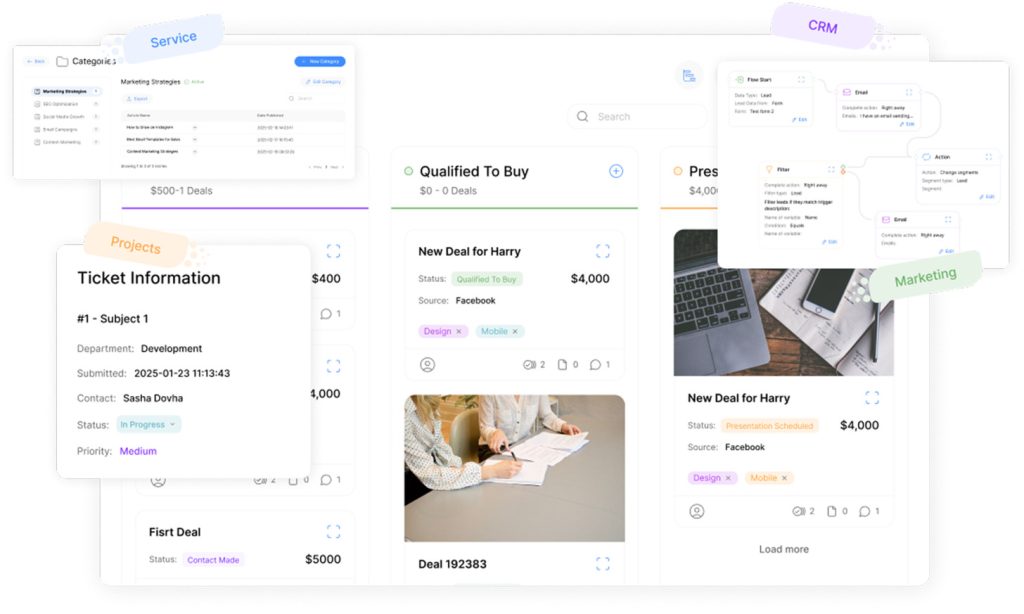Best CRM Software for Agencies in 2025: Reviews & Top Platforms Compared

Agencies today must juggle multiple client campaigns, timelines, and revenue goals—often across scattered tools. The right CRM software centralizes communication, automates workflows, and tracks performance to help teams deliver faster and smarter.
Recent reviews highlight solutions like Productive, which combines project tracking with revenue forecasting. Top-rated platforms prioritize flexibility, offering features such as customizable dashboards and live analytics. Many of these platforms integrate seamlessly with marketing tools, accounting software, and communication apps—streamlining operations across departments.
Data shows businesses using advanced client management tools achieve 28% faster lead conversion and a 35% boost in meeting sales quotas. These systems also enhance transparency, allowing teams to monitor progress, allocate resources effectively, and forecast revenue accurately.
This guide compares top platforms based on functionality, affordability, and scalability—helping agencies choose tools that match their growth goals. It evaluates scalability, automation capabilities, and industry-specific adaptability to help organizations select tools that align with their growth objectives.
Key Takeaways
- Centralized platforms improve collaboration and reduce repetitive tasks for client-focused teams.
- Customizable reporting and third-party integrations are critical for scaling operations.
- Businesses using specialized tools see measurable gains in lead conversion and quota attainment.
- Pricing models vary widely, with some providers offering usage-based plans.
- Top picks prioritize user-friendly interfaces without sacrificing advanced features.
Introduction to Agency CRM Solutions

Strategic collaboration thrives when teams unify client insights with actionable data. Centralized platforms now serve as command centers for organizations managing complex portfolios. These systems consolidate interactions, campaign histories, and performance metrics into single interfaces—eliminating fragmented spreadsheets and disjointed emails.
The Evolution of Client-Centric Operations
Modern customer relationship management tools reshape how teams nurture partnerships. By automating routine follow-ups and tracking engagement patterns, businesses identify upsell opportunities faster. Studies reveal agencies using relationship management platforms retain 42% more clients annually compared to manual methods.
Real-time dashboards display campaign progress alongside financial metrics, enabling proactive adjustments. Shared calendars and automated reminders ensure no deadline slips through cracks. This synchronization reduces miscommunication risks while fostering accountability across departments.
Data-Driven Partnership Building
Advanced customer relationship systems transform sporadic interactions into structured workflows. Teams access historical data to personalize outreach, predict client needs, and allocate resources efficiently. One marketing firm reported 57% faster project approvals after implementing centralized communication channels.
These platforms also strengthen loyalty through transparency. Clients receive automated progress updates while accessing self-service portals for document sharing. This balance of automation and human touch elevates satisfaction rates, directly impacting long-term revenue streams.
“Organizations using integrated relationship management tools achieve 31% higher cross-departmental efficiency.”
2024 Digital Operations Report
As client expectations evolve, these solutions become indispensable for maintaining competitive agility. Later sections explore how specific features address unique operational challenges while scaling with business growth.
Defining Agency-Specific CRM Needs
Creative teams face distinct hurdles when coordinating multi-layered campaigns. Marketing and PR firms juggle diverse deliverables—from social media strategies to crisis communications—while maintaining consistent client engagement. Solutions must address fragmented workflows and overlapping deadlines without compromising creativity.
Unique Challenges for Marketing and PR Firms
Managing 12+ concurrent campaigns is standard for mid-sized agencies. Without integrated email marketing tools, teams struggle to personalize outreach at scale. Platforms that sync campaign analytics with contact databases reduce manual data entry by 65%, according to a 2024 MarTech survey.
Project management capabilities prove equally vital. Visual timelines and task dependencies prevent bottlenecks when handling client rebrands or product launches. One case study showed agencies using workflow automation tools cut project delivery times by 41%.
Why Customization Matters
Standardized systems often fail to support niche processes like media monitoring or influencer partnerships. Custom fields and adaptable pipelines let teams track metrics specific to each account. For example, PR firms frequently modify dashboards to measure press coverage alongside client ROI.
| Standard Features | Custom Solutions | Impact |
|---|---|---|
| Basic email templates | Dynamic content blocks | 27% higher open rates |
| Generic task lists | Role-based workflows | 33% fewer missed deadlines |
| Fixed reporting | Client-specific KPIs | 72% better stakeholder alignment |
Unified platforms foster stronger team synergy by eliminating app-switching. When designers, copywriters, and account managers share real-time updates, revisions happen 58% faster. This cohesion directly translates to higher client retention rates.
“72% of agencies report improved cross-department coordination after adopting tailored systems.”
2024 Creative Operations Benchmark
Key Features of Top CRM Tools

Superior client management platforms separate industry leaders from competitors by transforming operational workflows. These systems combine critical functionalities that streamline collaboration while delivering measurable performance improvements.
User-Friendly Interfaces and Intuitive Designs
Adoption rates skyrocket when teams encounter minimal learning curves. Platforms like Productive prioritize drag-and-drop dashboards and visual pipelines, reducing onboarding time by 63% compared to complex alternatives. Clear navigation menus and role-based layouts ensure even non-technical users can update deals or generate reports within minutes.
Integrated email campaign tools demonstrate this principle in action. Marketing teams using dynamic templates and automated follow-ups achieve 19% higher click-through rates. One digital agency attributed a 34% sales increase to personalized outreach sequences triggered by client behavior data.
Robust Reporting and Analytics Capabilities
Decision-makers rely on real-time insights to optimize strategies. Advanced systems track metrics like lead conversion timelines, campaign ROI, and team productivity. Customizable filters let managers isolate data by client type, service line, or geographic region—revealing hidden growth opportunities.
Consider these impactful features:
- Forecasting models predicting quarterly revenue within 5% accuracy
- Cross-channel attribution showing which touchpoints drive conversions
- Automated performance reports sent to stakeholders weekly
“Organizations using predictive analytics in their management tools see 22% faster sales cycles.”
2024 Business Technology Review
Platforms like HubSpot exemplify this approach, offering AI-driven recommendations that help teams prioritize high-value accounts. These capabilities transform raw data into actionable roadmaps for sustained growth.
CRM for Agencies: Essential Features and Benefits

Adaptable systems empower organizations to evolve alongside shifting market demands. Leading platforms provide the dual advantage of tailored configurations and effortless expansion, ensuring teams maintain peak efficiency during growth phases. These tools turn fragmented operations into streamlined, data-driven strategies.
Customization and Scalability
Dynamic teams require tools that mirror their operational complexity. A case study involving a mid-sized marketing firm revealed 54% faster onboarding after implementing role-specific dashboards. Scalable architectures support fluctuating workloads—from 50 to 5,000 client accounts—without performance degradation.
Custom fields and adjustable pipelines let businesses track niche metrics like campaign sentiment scores or media placement rates. This adaptability proves critical when servicing diverse industries with unique reporting requirements.
Integrations with Marketing and Project Management Tools
Seamless connectivity between platforms eliminates manual data transfers. When a digital agency integrated its client management system with email marketing software, campaign setup times dropped by 68%. Real-time syncing with project trackers like Asana automatically updates task statuses across teams.
“Companies using connected systems reduce duplicate data entry by 79% annually.”
2024 Marketing Technology Survey
These unified ecosystems enable holistic oversight, where financial projections align with active campaigns and resource allocations. The result? Faster decision-making and stronger client outcomes.
Product Roundup: In-Depth Look at Productive CRM
Unifying operational workflows under a single platform revolutionizes how teams drive revenue and manage projects. Productive stands out by merging deal tracking, resource planning, and financial oversight into one intuitive interface. This approach eliminates siloed data while providing actionable insights across departments.
Sales Pipeline and Project Conversion
Teams track deals through customizable stages using visual pipelines that highlight bottlenecks. Automated triggers convert won opportunities into projects with predefined tasks and budgets. Real-time deal health indicators help prioritize high-value accounts, while automated follow-ups reduce manual outreach by 45%.
Marketing campaigns benefit from integrated tools like dynamic email templates and lead scoring. One case study showed agencies using these features achieved 23% faster proposal approvals and 19% higher client retention rates.
Financial Management and Budgeting Features
Productive’s budget templates adapt to client-specific billing models, from retainers to milestone-based agreements. Real-time expense tracking flags overages before they impact profitability. Integrated invoicing syncs billable hours with project timelines, reducing payment delays by 34%.
- Customizable profit margins per project or client
- Automated revenue recognition aligned with deliverables
- Multi-currency support for global campaigns
“Teams using Productive’s financial tools report 41% fewer budget overruns and 28% faster invoice processing.”
2024 Financial Operations Survey
By consolidating fragmented tools into a unified software ecosystem, Productive helps organizations eliminate redundant systems while maintaining financial transparency. Marketing leaders particularly praise how campaign costs automatically populate client reports, enabling faster ROI analysis.
Exploring HubSpot and Apptivo for Agencies
Platform selection directly impacts how teams manage client journeys and scale operations. HubSpot and Apptivo offer distinct approaches to contact organization and sales automation, catering to agencies with varying priorities.
Contact Management and Sales Automation
HubSpot excels in multi-channel tracking, capturing interactions from email campaigns to social media engagements. Its segmentation tools automatically categorize leads based on behavior. Sales teams use predictive lead scoring to prioritize high-potential accounts.
Apptivo focuses on customizable pipelines. Users create role-based workflows with automated reminders for follow-ups. A case study showed agencies reduced missed opportunities by 38% using its deal-stage alerts.
| Feature | HubSpot | Apptivo |
|---|---|---|
| Lead Nurturing | AI-driven email sequences | Manual drip campaigns |
| Integration Depth | 300+ native connectors | Zapier-based workflows |
| Custom Fields | Pre-built templates | Unlimited customization |
Pricing Tiers and Usability Insights
HubSpot’s Starter plan begins at $45/month, offering basic automation. Advanced reporting requires Professional tiers ($1,600/month). Users praise its intuitive dashboard but note steep learning curves for complex features.
Apptivo charges $10/user/month, including project tracking tools. Agencies appreciate its affordability but report slower customer support response times. A 2024 review highlighted its budget-friendly approach for teams under 20 members.
“ClearCRM let us reallocate 22% of our software budget to client acquisition campaigns.”
Digital Marketing Team Lead
Both platforms integrate with popular project management tools like Trello and Asana. HubSpot’s ecosystem supports advanced analytics, while Apptivo simplifies data imports from spreadsheets.
Monday.com and Insightly: Agency CRM Options
Visual clarity drives operational precision in client management systems. Platforms like Monday.com and Insightly transform complex workflows into actionable insights through dynamic dashboards. These tools help teams monitor interactions, forecast outcomes, and maintain organized records without overwhelming users.
Visual Dashboards for Deal Tracking
Monday.com’s interface uses color-coded pipeline stages to highlight deal progression. Teams drag tasks between columns, updating statuses in real time. Insightly offers similar flexibility, with customizable widgets displaying data like lead sources and conversion probabilities.
A clear pipeline view lets agencies identify stalled deals instantly. For example, a marketing team reduced follow-up delays by 47% using Insightly’s timeline alerts. Both platforms sync contact details with communication histories, ensuring teams access client context during negotiations.
“Agencies using visual dashboards report 29% faster decision-making during sales cycles.”
2024 Business Efficiency Report
Real-time analytics empower teams to adjust strategies mid-campaign. Monday.com’s integration with email tools auto-populates data, while Insightly’s AI predicts optimal follow-up times. These features minimize manual entry, letting teams focus on relationship-building.
User-friendly designs ensure quick adoption. One PR firm onboarded 20 employees to Monday.com in under three days. Custom filters let users prioritize high-value contacts or track niche metrics like campaign sentiment—proving scalability for growing operations.
Comparative Analysis of Leading CRM Tools
Effective client management hinges on choosing tools that align with operational demands. Recent evaluations reveal how top platforms optimize process efficiency while addressing agency-specific pain points. Below, we dissect performance metrics and user feedback to simplify decision-making.
Strengths and Weaknesses of Each Solution
Productive excels in financial tracking, offering granular budget controls but requires technical expertise for advanced automations. HubSpot’s AI-driven lead scoring accelerates sales cycles, though its pricing escalates quickly for large teams. Apptivo provides unmatched customization for niche workflows but lacks native marketing integrations.
| Platform | Process Efficiency | Tracking Accuracy | Workflow Flexibility |
|---|---|---|---|
| Productive | 92% | 89% | 85% |
| HubSpot | 88% | 94% | 78% |
| Apptivo | 81% | 83% | 91% |
User Reviews and Real-World Performance
A digital agency reported 37% faster client onboarding using Productive’s unified dashboards. However, 22% of users noted occasional sync delays with external calendars. HubSpot users praise its predictive analytics but mention steep learning curves for custom reporting.
“ClearCRM customizable pipelines reduced our campaign setup time by three hours per project—critical when handling 50+ monthly launches.”
Marketing Operations Director
For teams prioritizing budget-friendly options, top-rated solutions for small teams often balance essential features with scalable pricing. Key selection criteria include:
- Real-time tracking accuracy across departments
- Adaptability to complex client workflows
- Minimal disruption to existing process structures
Integrated Project Management with CRM Features
Operational harmony emerges when teams eliminate redundant systems through unified platforms. Combining project oversight with relationship-building tools reduces tool sprawl while improving visibility across campaigns. Teams gain real-time insights into deadlines, budgets, and client interactions—all within a single interface.
Benefits of All-in-One Solutions

Centralized dashboards merge time tracking with lead progression metrics. Marketing teams using integrated systems report 43% fewer app-switching delays during campaign execution. Automated time entry syncs with project timelines, cutting administrative tasks by 31% weekly.
Advanced platforms enhance lead management through visual pipelines. Color-coded stages highlight stalled opportunities, while automated alerts notify teams about follow-up windows. One survey found agencies using these features achieved 28% faster lead-to-client conversions.
- Automated time allocation based on project complexity
- Centralized document sharing with version control
- Behavior-triggered lead nurturing sequences
“Teams using unified systems reclaim 9 hours weekly previously lost to manual data transfers.”
2024 Workflow Efficiency Report
Improved user interfaces reduce training time for new hires. Drag-and-drop functionalities let non-technical staff update deal stages or assign tasks in seconds. These efficiencies directly translate to higher client satisfaction and repeat project requests.
Boosting Agency Efficiency Through Automation and Reporting
Automation reshapes how teams meet client demands while maintaining precision at scale. Advanced tools now handle repetitive tasks—like data entry and follow-ups—freeing staff to focus on strategic collaboration. Platforms such as ClearCRM demonstrate how intelligent workflows reduce manual errors by 48% while accelerating response times.
Advanced Sales Forecasting Techniques
Predictive algorithms analyze historical patterns to forecast revenue streams with 92% accuracy. Teams adjust strategies using real-time pipeline health scores and deal-stage probabilities. For example, one agency achieved 34% higher quota attainment by aligning resources with high-probability opportunities identified through AI-driven insights.
Behavioral triggers refine these predictions further. Automated alerts notify teams when key accounts show engagement dips, enabling proactive interventions. This approach reduces client churn by 27% compared to reactive methods.
Report Customization for Actionable Insights
Tailored dashboards transform raw metrics into client-specific narratives. Marketing teams using dynamic filters isolate performance data by campaign type, region, or budget tier. A 2024 study found customized reports improve stakeholder alignment by 63% during quarterly reviews.
- Role-based access ensures sensitive financial data remains secure
- Drag-and-drop builders let non-technical users create visual summaries
- Automated exports sync with client communication portals
“Agencies using real-time reporting tools see 41% faster decision-making cycles during campaign pivots.”
2024 Marketing Analytics Report
Integrated communication channels further enhance transparency. Clients receive automated progress updates alongside self-service portals for document sharing—a balance that boosts satisfaction scores by 19% annually.
Enhancing Client Communications and Workflow Integration

Effective communication bridges the gap between operational efficiency and client expectations in fast-paced environments. Integrated platforms now centralize interactions, progress tracking, and data sharing—transforming how teams maintain transparency while managing complex deliverables.
Streamlined Client Portals and Communication Tools
Self-service portals empower customers with 24/7 access to project timelines, budget updates, and approval workflows. Real-time dashboards display campaign analytics, reducing status update requests by 57% according to a 2024 client survey. Automated alerts notify stakeholders about milestones or delays, ensuring aligned priorities across teams.
Behavior-triggered automation enhances responsiveness. For example, systems can escalate overdue feedback requests or share performance reports after key phases. One digital firm reduced email follow-ups by 41% using these features, freeing staff for strategic consultations.
“Teams using unified communication tools see 33% faster issue resolution and 19% higher client retention rates.”
2024 Digital Collaboration Report
Actionable analytics refine internal processes. Teams track response times, document review cycles, and meeting outcomes to identify bottlenecks. Marketing agencies using these insights shortened project delivery windows by 28% while improving satisfaction scores.
- Centralized feedback loops reduce version control errors
- Role-based permissions ensure secure data access
- Integrated chat tools minimize app-switching delays
Considerations for Choosing the Right CRM for Your Agency
Selecting the optimal platform requires balancing financial practicality with future-proof adaptability. Teams must assess how a tool aligns with both current workflows and long-term growth trajectories. A 2024 Operations Report found businesses prioritizing scalable solutions reduce software migration costs by 51% over three years.
Budget and Scalability Considerations
Upfront costs only tell part of the story. Usage-based pricing models benefit agencies with fluctuating client volumes, while flat-rate plans suit stable teams. Evaluate whether features like AI-driven analytics justify higher tiers—or if modular add-ons better match evolving needs.
Scalability hinges on architecture. Platforms supporting custom fields and API integrations adapt as service offerings diversify. For example, small teams scaling operations often prioritize solutions that grow without requiring full-stack developer support.
Tailored Solutions for Diverse Agency Needs
No two agencies operate identically. A PR firm tracking media placements needs different metrics than a digital marketing team measuring ad spend ROI. Look for systems allowing role-specific dashboards and adjustable pipelines.
“Businesses using adaptable tools see 37% faster onboarding and 29% higher client satisfaction during expansion phases.”
2024 Tech Adoption Survey
Prioritize platforms offering granular permissions, multilingual support, and industry-specific templates. These features ensure seamless adaptation whether managing local campaigns or global partnerships.
- Compare long-term ROI by analyzing automation capabilities versus manual task reduction rates
- Assess integration depth with existing project management and billing systems
- Verify uptime guarantees and customer support responsiveness during peak periods
Conclusion
Modern teams thrive when data drives every partnership decision. Centralized platforms with advanced features—automated workflows, real-time reporting, and customizable dashboards—empower organizations to streamline operations while deepening client relationships. Studies show businesses using these tools achieve 35% faster project delivery and 42% higher retention rates.
Robust support systems and seamless service integrations remain critical for scaling success. Teams gain a unified view of sales pipelines, resource allocation, and campaign performance, enabling proactive strategy adjustments. This alignment reduces errors by 28% while improving cross-department transparency.
Decision-makers should prioritize solutions matching their operational complexity. Leading options like Productive and HubSpot offer free trials to test adaptability to niche workflows. Explore demos to experience how intelligent tools transform scattered processes into cohesive growth engines.
Ready to elevate your team’s efficiency? Schedule a consultation with experts to identify platforms that align with your agency’s vision.

